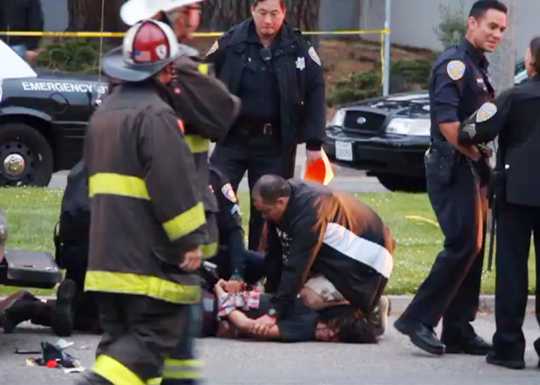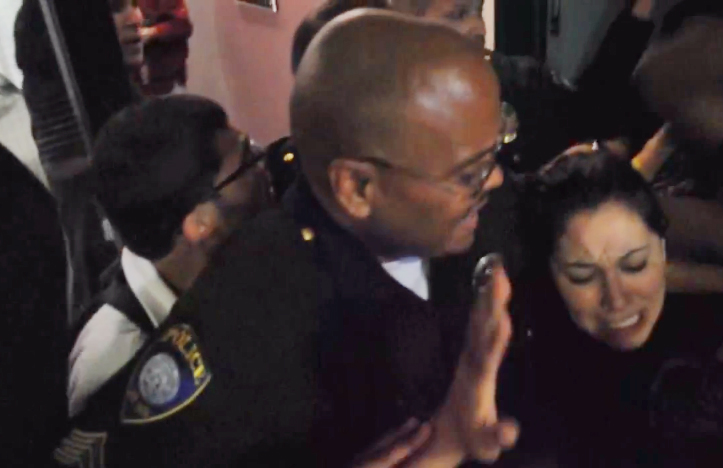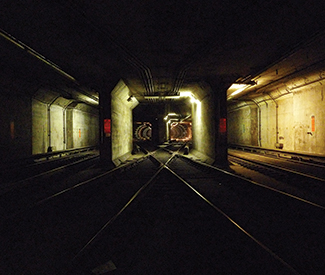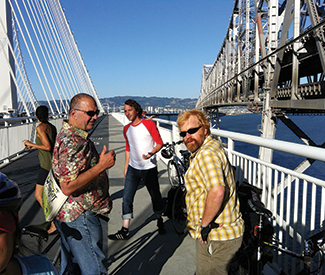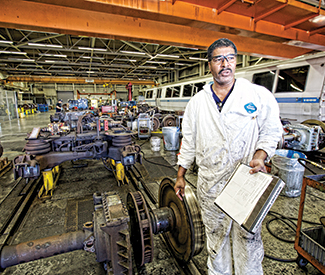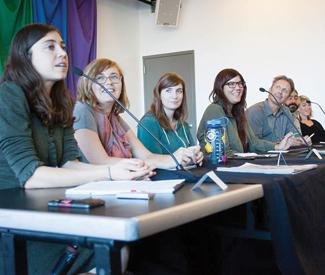WEDNESDAY 7
ROCK
Bottom of the Hill: 1233 17th St., San Francisco. Nothington, Masked Intruder, Elway, Sam Russo, 9 p.m., $10-$12.
DNA Lounge: 375 11th St., San Francisco. White Wizzard, Hysteria, Midnight Chaser, 8 p.m., $10-$13.
El Rio: 3158 Mission, San Francisco. Andalusia Rose, Magic Fight, Zigtbera, 8th Grader, 8 p.m., $5.
Hotel Utah: 500 Fourth St., San Francisco. International Pop Overthrow – Day 1, w/ Chris von Sneidern, Northern Son, Lannie Flowers, The Last Out, Hot Nun, Blake Jones & The Trike Shop, 7:30 p.m., $10.
The Knockout: 3223 Mission, San Francisco. The Mystery Men?, RocketShip RocketShip, Buzzy Frets, 9:30 p.m., $7.
Rickshaw Stop: 155 Fell, San Francisco. White Fence, Jessica Pratt, Jonathan Rado, 8 p.m., $12.
DANCE
The Cafe: 2369 Market, San Francisco. “Sticky Wednesdays,” w/ DJ Mark Andrus, 8 p.m., free.
Cat Club: 1190 Folsom, San Francisco. “Bondage A Go Go,” w/ DJs Damon, Tomas Diablo, & guests, 9:30 p.m., $5-$10.
The Cellar: 685 Sutter, San Francisco. “Eye Candy Wednesdays,” 9 p.m., free.
Club X: 715 Harrison, San Francisco. “Electro Pop Rocks,” 18+ dance party with Eptic, Jays One, Sound It Out, Tywrex, SwitchBlade, Brandon Lee Marble, Shane Fontane, Chris Gonzalez, Juan Beatz, Vyruz, Liquid Abyss, Robo7food, 9 p.m., $15-$20.
F8: 1192 Folsom St., San Francisco. “Housepitality,” w/ Claude Young, Tyrel Williams, Kawa, Bai-ee, 9 p.m., $5-$10.
Harlot: 46 Minna, San Francisco. “Qoöl,” 5 p.m.
Infusion Lounge: 124 Ellis, San Francisco. “Indulgence,” 10 p.m.
Lookout: 3600 16th St., San Francisco. “What?,” 7 p.m.
MatrixFillmore: 3138 Fillmore, San Francisco. “Innov8,” 8 p.m.
Monarch: 101 6th St., San Francisco. “Soul Phunktion,” w/ resident DJs Kimmy Le Funk, Primo, and M3, 9 p.m.
Q Bar: 456 Castro, San Francisco. “Booty Call,” w/ Juanita More, Joshua J, guests, 9 p.m., $3.
HIP-HOP
Double Dutch: 3192 16th St., San Francisco. “Cash IV Gold,” w/ DJs Kool Karlo, Roost Uno, and Sean G, 10 p.m., free.
John Colins: 138 Minna, San Francisco. BPos, Dublin, Melina Jones, Orukusaki, Gigio, 9 p.m., $10.
Skylark Bar: 3089 16th St., San Francisco. “Mixtape Wednesday,” w/ resident DJs Strategy, Junot, Herb Digs, & guests, 9 p.m., $5.
ACOUSTIC
Brick & Mortar Music Hall: 1710 Mission, San Francisco. Mountain Standard Time, 6 p.m., free.
Cafe Divine: 1600 Stockton, San Francisco. Craig Ventresco & Meredith Axelrod, 7 p.m., free.
Johnny Foley’s Irish House: 243 O’Farrell St., San Francisco. Terry Savastano, Every other Wednesday, 9 p.m., free.
Plough & Stars: 116 Clement, San Francisco. Jeanie & Chuck’s Bluegrass Country Jam, First Wednesday of every month, 9 p.m., free.
Union Square Park: 333 Post, San Francisco. The Easy Leaves, 12:30 p.m., free.
Yoshi’s San Francisco: 1330 Fillmore, San Francisco. Don Ross, 8 p.m., $21-$25.
JAZZ
Amnesia: 853 Valencia, San Francisco. Gaucho, Eric Garland’s Jazz Session, The Amnesiacs, 7 p.m., free.
Burritt Room: 417 Stockton St., San Francisco. Terry Disley’s Rocking Jazz Trio, 6 p.m., free.
Club Deluxe: 1511 Haight, San Francisco. Patrick Wolff, Every other Wednesday, 8:30 p.m., free.
Jazz Bistro At Les Joulins: 44 Ellis, San Francisco. Charles Unger Experience, 7:30 p.m., free.
Le Colonial: 20 Cosmo, San Francisco. The Cosmo Alleycats featuring Ms. Emily Wade Adams, 7 p.m., free.
Oz Lounge: 260 Kearny, San Francisco. Hard Bop Collective, 6 p.m., free.
Rasselas Ethiopian Cuisine & Jazz Club: 1534 Fillmore, San Francisco. M.B. Hanif & The Sound Voyagers, 8 p.m.
Savanna Jazz Club: 2937 Mission, San Francisco. “Cat’s Corner,” 9 p.m., $10.
Top of the Mark: One Nob Hill, 999 California, San Francisco. Ricardo Scales, Wednesdays, 6:30-11:30 p.m., $5.
Zingari: 501 Post, San Francisco. Brenda Reed, 7:30 p.m., free.
INTERNATIONAL
Bissap Baobab: 3372 19th St., San Francisco. Timba Dance Party, w/ DJ WaltDigz, 10 p.m., $5.
Boom Boom Room: 1601 Fillmore, San Francisco. Cha-Ching, First Wednesday of every month, 9 p.m., $5.
Brick & Mortar Music Hall: 1710 Mission, San Francisco. The Garifuna Collective with Danny Michel, Razteria, DJ Juan Data, 9 p.m., $15-$18.
Cafe Cocomo: 650 Indiana, San Francisco. “Bachatalicious,” w/ DJs Good Sho & Rodney, 7 p.m., $5-$10.
Cigar Bar & Grill: 850 Montgomery, San Francisco. Bamba 5, 8 p.m.
Pachamama Restaurant: 1630 Powell, San Francisco. “Cafe LatinoAmericano,” 8 p.m., $5.
Union Square Park: 333 Post, San Francisco. LaTiDo, 6 p.m., free.
BLUES
Biscuits and Blues: 401 Mason, San Francisco. Samuel James & Kevin So, 8 & 10 p.m., $15.
SOUL
The Cellar: 685 Sutter, San Francisco. “Color Me Badd,” w/ DJ Matt Haze, Wednesdays, 5-9 p.m.
Lexington Club: 3464 19th St., San Francisco. “Secret Lovers,” w/ DJs Ponyboy, Lil MC, Katie Duck, and Durt, First Wednesday of every month, 9 p.m., free.
The Royal Cuckoo: 3202 Mission, San Francisco. Freddie Hughes & Chris Burns, 7:30 p.m., free.
THURSDAY 8
ROCK
Brick & Mortar Music Hall: 1710 Mission, San Francisco. Outside Lands Night Show: Smith Westerns, Wampire, Social Studies, 8 p.m., $20 (Outside Lands festival ticket required).
California Academy of Sciences: 55 Music Concourse, San Francisco. Outside Lands NightLife: Outside Lands Night Show with The Growlers, Houndmouth, DJ Andy Cabic, 6 p.m., $12 (Outside Lands festival ticket not required).
S.F. Eagle: 398 12th St., San Francisco. Thursday Nite Live: Icky Boyfriends, Wet Illustrated, Violent Change, 9 p.m., $8.
Hotel Utah: 500 Fourth St., San Francisco. International Pop Overthrow – Day 2, w/ French Boutik, Preoccupied Pipers, Hope Chest, The Corner Laughers, The Clarences, Sea Dramas, 7:30 p.m., $10.
The Knockout: 3223 Mission, San Francisco. Glitter Wizard, Creepers, Wild Honey, 10 p.m., $7.
Monarch: 101 6th St., San Francisco. Inferno of Joy, My New Vice, Flexx Bronco, Bite, 8 p.m.
Rickshaw Stop: 155 Fell, San Francisco. “Popscene,” w/ Smallpools, Savoir Adore, Cloud Control, 9 p.m., $12-$14.
DANCE
Abbey Tavern: 4100 Geary, San Francisco. DJ Schrobi-Girl, 10 p.m., free.
Amoeba Music: 1855 Haight, San Francisco. Pretty Lights (DJ set), 4 p.m., free.
Aunt Charlie’s Lounge: 133 Turk, San Francisco. “Tubesteak Connection,” w/ DJ Bus Station John, 9 p.m., $5-$7.
The Cafe: 2369 Market, San Francisco. “¡Pan Dulce!,” 9 p.m., $5.
Cat Club: 1190 Folsom, San Francisco. “All ‘80s Thursdays,” w/ DJs Damon, Steve Washington, Dangerous Dan, and guests, 9 p.m., $6 (free before 9:30 p.m.).
The Cellar: 685 Sutter, San Francisco. “XO,” w/ DJs Astro & Rose, 10 p.m., $5.
Club X: 715 Harrison, San Francisco. “The Crib,” 9:30 p.m., $10, 18+.
Danzhaus: 1275 Connecticut, San Francisco. “Alt.Dance,” Second Thursday of every month, 7 p.m., $7, 18+.
DNA Lounge: 375 11th St., San Francisco. “8bitSF,” w/ Space Town Savior, Slime Girls, 1000 Needles, Adonisaurus, DJ La Facé, 9 p.m., $8-$11.
Elbo Room: 647 Valencia, San Francisco. “Afrolicious,” w/ DJs Pleasuremaker, Señor Oz, and live guests, 9:30 p.m., $5-$7.
The EndUp: 401 Sixth St., San Francisco. EDMSF Thursdays, 10 p.m., $10 (free before midnight).
F8: 1192 Folsom St., San Francisco. “Black Rock Big Bottom: A Burning Man Fundraiser for the Janky Barge,” w/ NVO, Matt Haze, Shouts!, Absurge, Ma Yeah, Gordo Cabeza, Phleck, Spank Bank, Lobo, $5-$10.
Infusion Lounge: 124 Ellis, San Francisco. “I Love Thursdays,” 10 p.m., $10.
Madrone Art Bar: 500 Divisadero, San Francisco. “Night Fever,” 9 p.m., $5 after 10 p.m.
MatrixFillmore: 3138 Fillmore, San Francisco. “Fusion,” w/ DJ Big Bad Bruce, 9 p.m., $5.
Mezzanine: 444 Jessie, San Francisco. “Fools in the Night,” w/ Lifelike, The Aston Shuffle, The Schmidt, 9 p.m., $10-$15.
Q Bar: 456 Castro, San Francisco. “Throwback Thursday,” w/ DJ Jay-R, 9 p.m., free.
Raven: 1151 Folsom St., San Francisco. “1999,” w/ VJ Mark Andrus, 8 p.m., free.
Ruby Skye: 420 Mason, San Francisco. “Awakening,” w/ Project 46, KhoMha, 9 p.m., $15-$20 advance.
The Tunnel Top: 601 Bush, San Francisco. “Tunneltop,” DJs Avalon and Derek ease you into the weekend with a cool and relaxed selection of tunes spun on vinyl, 10 p.m., free.
Underground SF: 424 Haight, San Francisco. “Bubble,” 10 p.m., free.
Vessel: 85 Campton, San Francisco. “Base,” w/ Fur Coat, 10 p.m., $5-$10.
HIP-HOP
Eastside West: 3154 Fillmore, San Francisco. “Throwback Thursdays,” w/ DJ Madison, 9 p.m., free.
John Colins: 138 Minna, San Francisco. “Party with Friends,” w/ resident DJs IllEfect, GeektotheBeat, Merrick, and Delrokz, Second Thursday of every month, 9 p.m., free.
Neck of the Woods: 406 Clement St., San Francisco. “Skratchpad,” Second Thursday of every month, 10 p.m., free.
Park 77 Sports Bar: 77 Cambon, San Francisco. “Slap N Tite,” w/ resident Cali King Crab DJs Sabotage Beats & Jason Awesome, free.
The Parlor: 2801 Leavenworth, San Francisco. “Locals Night Out,” w/ DJ Illy D, 9 p.m., free.
Skylark Bar: 3089 16th St., San Francisco. “Peaches,” w/lady DJs DeeAndroid, Lady Fingaz, That Girl, Umami, Inkfat, and Andre, 10 p.m., free.
ACOUSTIC
Atlas Cafe: 3049 20th St., San Francisco. The Kentucky Twisters, 8 p.m., free.
Boom Boom Room: 1601 Fillmore, San Francisco. Antoine Dufour, Craig D’Andrea, Adrian Bellue, 9:30 p.m., $10.
Cafe Du Nord: 2170 Market, San Francisco. Goodnight, Texas; Fox & Woman; Vandella, 8 p.m., $10.
Plough & Stars: 116 Clement, San Francisco. Emperor Norton Céilí Band, 9 p.m.
Thee Parkside: 1600 17th St., San Francisco. Chris Shiflett & The Dead Peasants, Rod Melancon, Misisipi Mike Wolf, 9 p.m., $10.
JAZZ
Blush! Wine Bar: 476 Castro, San Francisco. Doug Martin’s Avatar Ensemble, 7:30 p.m., free.
Bottle Cap: 1707 Powell, San Francisco. The North Beach Sound with Ned Boynton, Jordan Samuels, and Tom Vickers, 7 p.m., free.
The Chapel: 777 Valencia St., San Francisco. Ralph Carney’s Serious Jass Project, 8:30 p.m., free.
Cigar Bar & Grill: 850 Montgomery, San Francisco. Jimmy Grant Quartet, 7 p.m., free.
Club Deluxe: 1511 Haight, San Francisco. Michael Parsons, 8:30 p.m., free.
Feinstein’s at the Nikko: 222 Mason St., San Francisco. Ariana Savalas, 8 p.m.
Le Colonial: 20 Cosmo, San Francisco. Steve Lucky & The Rhumba Bums, 7:30 p.m.
Pier 23 Cafe: Pier 23, San Francisco. Primavera, 7 p.m., free.
The Royal Cuckoo: 3202 Mission, San Francisco. Chris Siebert, 7:30 p.m., free.
Savanna Jazz Club: 2937 Mission, San Francisco. Savanna Jazz Jam with Eddy Ramirez, 7:30 p.m., $5.
Top of the Mark: One Nob Hill, 999 California, San Francisco. Stompy Jones, 7:30 p.m., $10.
Yerba Buena Gardens: Fourth St. & Mission, San Francisco. Kally Price Old Blues & Jazz Band, 12:30 p.m., free.
Zingari: 501 Post, San Francisco. Anya Malkiel, 7:30 p.m., free.
INTERNATIONAL
Bissap Baobab: 3372 19th St., San Francisco. “Pa’Lante!,” w/ Juan G, El Kool Kyle, Mr. Lucky, 10 p.m., $5.
Pachamama Restaurant: 1630 Powell, San Francisco. “Jueves Flamencos,” 8 p.m., free.
Rasselas Ethiopian Cuisine & Jazz Club: 1534 Fillmore, San Francisco. Latin Breeze, 8 p.m.
Verdi Club: 2424 Mariposa, San Francisco. The Verdi Club Milonga, w/ Christy Coté, DJ Emilio Flores, guests, 9 p.m., $10-$15.
Yoshi’s San Francisco: 1330 Fillmore, San Francisco. The Gypsy Allstars, 8 p.m., $26-$30.
REGGAE
50 Mason Social House: 50 Mason, San Francisco. The Steady 45s, 9 p.m., free.
Make-Out Room: 3225 22nd St., San Francisco. “Festival ‘68,” w/ Revival Sound System, Second Thursday of every month, 9:30 p.m., free.
Pissed Off Pete’s: 4528 Mission St., San Francisco. Reggae Thursdays, w/ resident DJ Jah Yzer, 9 p.m., free.
BLUES
50 Mason Social House: 50 Mason, San Francisco. Bill Phillippe, 5:30 p.m., free.
Biscuits and Blues: 401 Mason, San Francisco. Dave Keller & Kevin So, Aug. 8-9, 7:45 & 10 p.m., $20.
Jazz Bistro At Les Joulins: 44 Ellis, San Francisco. Bohemian Knuckleboogie, 7:30 p.m., free.
COUNTRY
Bottom of the Hill: 1233 17th St., San Francisco. The Goddamn Gallows, The Calamity Cubes, Kountry Kittens, 9 p.m., $10-$12.
EXPERIMENTAL
Hemlock Tavern: 1131 Polk, San Francisco. Headboggle, Marielle Jakobsons, Good Willsmith, Black Hat, 8 p.m., $7.
The Luggage Store: 1007 Market, San Francisco. Jim Kaiser, Matt Davignon, Toaster, 8 p.m., $6-$10.
FRIDAY 9
ROCK
50 Mason Social House: 50 Mason, San Francisco. Black Crystal Wolf Kids, Electric Sheep, Thrillouette, 9 p.m., $10.
America’s Cup Pavilion: 27 Pier, San Francisco. The Trims, 3:30 p.m., free.
Bottom of the Hill: 1233 17th St., San Francisco. Daikon, Worth Taking, Upstairs Downstairs, 9:30 p.m., $10.
Brick & Mortar Music Hall: 1710 Mission, San Francisco. North American Scum; Tall Fires; Devon McClive & Sons; Gamble, Gamble, Die; Ben Davila & The Spectacles, 8 p.m., $10.
Hemlock Tavern: 1131 Polk, San Francisco. Burnt Ones, The Hussy, POW!, 9:30 p.m., $7.
Hotel Utah: 500 Fourth St., San Francisco. International Pop Overthrow – Day 3, w/ Stormy Strong, The Relatives, Agony Aunts, The Bobbleheads, Butch Berry, Sean O’Brien & His Dirty Hands, Sarah Petrella, 7:30 p.m., $10.
Milk Bar: 1840 Haight, San Francisco. Dirty Ghosts, The Tambo Rays, DJ Russell Quan, 8 p.m., $5.
Neck of the Woods: 406 Clement St., San Francisco. Body Parts, Maston, on the downstairs stage, 9 p.m., $5.
Rickshaw Stop: 155 Fell, San Francisco. Outside Lands Night Show: Milo Greene, Wild Belle, 10 p.m., $16 (Outside Lands festival ticket required).
Sub-Mission Art Space (Balazo 18 Gallery): 2183 Mission, San Francisco. Free Marissa Alexander: A Benefit Show & Call for Action, Fundraiser for the Marissa Alexander Legal Defense Fund with music by Heart of Orion, Betaray, and Allana Muhammad, plus art by Malik and Marissa Arterberry., 6-11 p.m., $10.
DANCE
1015 Folsom: 1015 Folsom St., San Francisco. Alice Glass, Jupiter Keyes, Sango, Marco de la Vega, DJ Dials, DJ Primo, Chauncey CC, 10 p.m., $17.50 advance.
Amnesia: 853 Valencia, San Francisco. “Indie Slash,” w/ resident DJs Danny White & Rance, 10 p.m., $5.
BeatBox: 314 11th St., San Francisco. “Bears in the Dark,” w/ DJ John LePage, 9 p.m., $5-$10.
Cafe Flore: 2298 Market, San Francisco. “Kinky Beats,” w/ DJ Sergio, 10 p.m., free.
The Cafe: 2369 Market, San Francisco. “Boy Bar,” w/ DJ Matt Consola, 9 p.m., $5.
Cat Club: 1190 Folsom, San Francisco. “Dark Shadows: Immortal,” w/ DJs Daniel Skellington, Panic, Melting Girl, and Tomas Diablo, 9:30 p.m., $7 ($3 before 10 p.m.).
The Cellar: 685 Sutter, San Francisco. “F.T.S.: For the Story,” 10 p.m.
Elbo Room: 647 Valencia, San Francisco. “Last Nite: A 2000s Indie Dance Party,” w/ DJs EmDee & Jamie Jams, Second Friday of every month, 10 p.m., $5-$10.
The EndUp: 401 Sixth St., San Francisco. “Fever,” 10 p.m., free before midnight.
F8: 1192 Folsom St., San Francisco. “Vintage,” w/ DJ Toph One & guests, 5 p.m., free.
The Grand Nightclub: 520 4th St., San Francisco. “We Rock Fridays,” 9:30 p.m.
Infusion Lounge: 124 Ellis, San Francisco. “Escape Fridays,” 10 p.m., $20.
Lone Star Saloon: 1354 Harrison, San Francisco. “Cubcake,” w/ DJ Medic, Second Friday of every month, 9 p.m.
Lookout: 3600 16th St., San Francisco. “HYSL,” 9 p.m., $3.
MatrixFillmore: 3138 Fillmore, San Francisco. “F-Style Fridays,” w/ DJ Jared-F, 9 p.m.
Mezzanine: 444 Jessie, San Francisco. Glass Candy, DJ Omar, Stanley Frank, Bus Station John, 9 p.m., $20.
Mighty: 119 Utah, San Francisco. “As You Like It + No Way Back,” w/ Metro Area, Christina Chatfield, Conor, Solar, Mossmoss, Carlos Souffront, Sassmouth, Rich Korach, Tyrel Williams, 9 p.m., $10-$20.
Monarch: 101 6th St., San Francisco. Stanton Warriors, All Good Funk Alliance, Gene Hunt, Sharon Buck, 9 p.m., $10.
Neck of the Woods: 406 Clement St., San Francisco. Viceroy, Plastic Plates, Bit Funk, on the upstairs stage, 9 p.m., $10-$12.
Public Works: 161 Erie, San Francisco. “Heart Deco: Ignite – Final Pre-Burn Heart Phoenix Fundraiser,” w/ Troy Pierce, Lazaro Casanova, Dax Lee, Atish, Josh Vincent, Derek Hena, Jen Woolfe, Vitamindevo, Jaybee, Jive, more, 9 p.m., $10-$20.
Q Bar: 456 Castro, San Francisco. “Pump: Worq It Out Fridays,” w/ resident DJ Christopher B, 9 p.m., $3.
Ruby Skye: 420 Mason, San Francisco. Eddie Halliwell, 9 p.m., $20-$25 advance.
Showdown: 10 Sixth St., San Francisco. “Electric WKND,” w/ The Certain People Crew, Second Friday of every month, 10 p.m., free.
Slide: 430 Mason, San Francisco. “E2F,” Second Friday of every month, 9 p.m.
Supperclub San Francisco: 657 Harrison, San Francisco. “Beach Party,” w/ DJs Playdoughboy, Pollux, Taj, Kyoto, and Telshak, 10 p.m., free if wearing flippers.
Temple: 540 Howard, San Francisco. “Trap City: Summer Gold,” w/ Gents & Jawns, Clicks & Whistles, Djunya, UltraViolet, Napsty, Ben Seagren, Dean Samaras, Matt Kramer, Darren Grayson, DJ Tone, DJ Von, 10 p.m., $15-$25.
Vessel: 85 Campton, San Francisco. Bart B More, KonMan, 10 p.m., $10-$30.
Wish: 1539 Folsom, San Francisco. “Bridge the Gap,” w/ resident DJ Don Kainoa, Fridays, 6-10 p.m., free.
HIP-HOP
EZ5: 682 Commercial, San Francisco. “Decompression,” Fridays, 5-9 p.m.
John Colins: 138 Minna, San Francisco. “Heartbeat,” w/ resident DJ Strategy, Second Friday of every month, 9 p.m., $5 (free before 11 p.m).
Slate Bar: 2925 16th St., San Francisco. “The Hustle,” w/ DJs Sake One & Sean G, Second Friday of every month, 9 p.m.
Yoshi’s San Francisco: 1330 Fillmore, San Francisco. Ras Kass, 10:30 p.m., $23-$26.
ACOUSTIC
Bazaar Cafe: 5927 California, San Francisco. “Sing Out of Darkness,” American Foundation for Suicide Prevention benefit featuring Obstacle Course, David Whitaker, Michael Vincent, Johnny Lawrie, and host Julie Mayhew, 6:30 p.m.
Plough & Stars: 116 Clement, San Francisco. The GoldDiggers, Josephine Johnson, 9 p.m.
Slim’s: 333 11th St., San Francisco. The Big Ass Hillbilly Show, w/ The Trespassers, Emily Bonn & The Vivants, The Muddy Roses, Shani Chabansky, 9 p.m., $15.
The Sports Basement: 610 Old Mason, San Francisco. “Breakfast with Enzo,” w/ Enzo Garcia, 10 a.m., $5.
Thee Parkside: 1600 17th St., San Francisco. Whiskey Shivers, Wild Child, Grow & Twine, 9 p.m., $10.
Velo Rouge Cafe: 798 Arguello, San Francisco. Hannah & Maggie, 7 p.m., free.
JAZZ
Beach Chalet Brewery & Restaurant: 1000 Great Highway, San Francisco. Johnny Smith, 8 p.m., free.
Bird & Beckett: 653 Chenery, San Francisco. Jimmy Ryan Quintet, Second Friday of every month, 5:30 p.m., free.
Cafe Royale: 800 Post, San Francisco. The Glasses, 9 p.m.
Center for New Music: 55 Taylor St., San Francisco. Glass Brick Boulevard, 7:30 p.m., $10-$15.
The Emerald Tablet: 80 Fresno St., San Francisco. Glen Pearson, 8 p.m., $5-$10.
Jazz Bistro At Les Joulins: 44 Ellis, San Francisco. Charles Unger Experience, 7:30 p.m., free.
Pier 23 Cafe: Pier 23, San Francisco. Legends & Friends, 8 p.m., free.
The Royal Cuckoo: 3202 Mission, San Francisco. Jules Broussard, Danny Armstrong, and Chris Siebert, 7:30 p.m., free.
Savanna Jazz Club: 2937 Mission, San Francisco. Jim Butler Quartet, Aug. 9-10, 7:30 p.m., $8.
Top of the Mark: One Nob Hill, 999 California, San Francisco. Black Market Jazz Orchestra, 9 p.m., $10.
Yerba Buena Gardens: Fourth St. & Mission, San Francisco. Chelle! & Friends, 11 a.m. & 12:15 p.m., free.
Zingari: 501 Post, San Francisco. Joyce Grant, 8 p.m., free.
INTERNATIONAL
Bissap Baobab: 3372 19th St., San Francisco. “Makossa West,” w/ The Latin Soul Brothers (Wonway Posibul & Joe Quixx), Second Friday of every month, 10 p.m., $5.
Cafe Cocomo: 650 Indiana, San Francisco. Taste Fridays, featuring local cuisine tastings, salsa bands, dance lessons, and more, 7:30 p.m., $15 (free entry to patio).
Cigar Bar & Grill: 850 Montgomery, San Francisco. Montuno Swing, 8 p.m.
Little Baobab: 3388 19th St., San Francisco. “Paris-Dakar African Mix Coupe Decale,” 10 p.m.
Pachamama Restaurant: 1630 Powell, San Francisco. Cuban Night with Fito Reinoso, 7:30 & 9:15 p.m., $15-$18.
REGGAE
Gestalt Haus: 3159 16th St., San Francisco. “Music Like Dirt,” 7:30 p.m., free.
Yoshi’s San Francisco: 1330 Fillmore, San Francisco. Mystic Roots, 8 p.m., $16-$19.
BLUES
Biscuits and Blues: 401 Mason, San Francisco. Dave Keller & Kevin So, Aug. 8-9, 7:45 & 10 p.m., $20.
Boom Boom Room: 1601 Fillmore, San Francisco. Bill Phillippe, 6 p.m., free.
Lou’s Fish Shack: 300 Jefferson St., San Francisco. Nat Bolden, 8:30 p.m.
FUNK
Boom Boom Room: 1601 Fillmore, San Francisco. Katdelic with Angelo Moore, Keno Mapp, and Eric McFadden, 9:30 p.m., $15 advance.
Make-Out Room: 3225 22nd St., San Francisco. “Loose Joints,” w/ DJs Centipede, Damon Bell, & Tom Thump, 10 p.m., $5.
SOUL
Cafe Du Nord: 2170 Market, San Francisco. The Inciters, French Boutik, The Slippery Slope, 9:30 p.m., $10.
Edinburgh Castle: 950 Geary, San Francisco. “Soul Crush,” w/ DJ Serious Leisure, 10 p.m., free.
El Rio: 3158 Mission, San Francisco. Friday Live: Queer Oldies Soul Review, 10 p.m., free.
The Knockout: 3223 Mission, San Francisco. “Nightbeat,” w/ DJs Primo, Lucky, and Dr. Scott, Second Friday of every month, 10 p.m., $4.
Madrone Art Bar: 500 Divisadero, San Francisco. “Yo Momma: M.O.M. Weekend Edition,” w/ DJ Gordo Cabeza, Second Friday of every month, 9 p.m., $5 (free before 10 p.m.).
The Ramp: 855 Terry Francois, San Francisco. “Soul Soirée,” w/ Myxx Elements Band, 6 p.m.
SATURDAY 10
ROCK
Bender’s: 806 S. Van Ness, San Francisco. Rum Rebellion, Absinthe Rose, The Pot House Shindies, 10 p.m., $5.
Bottom of the Hill: 1233 17th St., San Francisco. Tomihira, Space Waves, In Letter Form, 9:30 p.m., $10.
Brick & Mortar Music Hall: 1710 Mission, San Francisco. Outside Lands Night Show: King Tuff, The Men, Twin Peaks, 10 p.m., $20 (Outside Lands festival ticket required).
Cafe Du Nord: 2170 Market, San Francisco. Igor & Red Elvises, The Custom Kicks, 9:30 p.m., $20.
The Chapel: 777 Valencia St., San Francisco. MarchFourth Marching Band, DJ Shotnez, 9 p.m., $20-$25.
El Rio: 3158 Mission, San Francisco. Burn River Burn, Chris James & The Showdowns, The Messiah Complex, Eric Friedmann & The Lucky Rubes, 3 p.m., $10.
Hemlock Tavern: 1131 Polk, San Francisco. Rotfest IV, w/ 3 Stoned Men, Icky Boyfriends, Cameltoe, UKE Band, Junior Executives, Pineapple Princess, We Could Be Friends, The Peddlers, 5 p.m., $10.
Hotel Utah: 500 Fourth St., San Francisco. International Pop Overthrow – Day 4, w/ Talk Tonight, Eric Friedmann & The Lucky Rubes, The Connies, The Bottle Kids, Zero Pop, The Whitehalls, David Brookings, 7:30 p.m., $10.
The Lab: 2948 16th St., San Francisco. “Replicant: Part III,” w/ Grayceon, Wreck & Reference, Botanist, Red Light, 9 p.m., $5-$8.
Live Worms Gallery: 1345 Grant, San Francisco. Sad Tires, Sweet Water, Kiwi Time, DJ Nasty Nettles, 7 p.m., $8.
Milk Bar: 1840 Haight, San Francisco. Zodiac Death Valley, Cannons & Clouds, DJ Vin Sol, 8:30 p.m., $5.
Slim’s: 333 11th St., San Francisco. Evolution, Powerage, 9 p.m., $15.
DANCE
Amnesia: 853 Valencia, San Francisco. “2 Men Will Move You,” w/ DJs Primo & Jordan, Second Saturday of every month, 9 p.m.
BeatBox: 314 11th St., San Francisco. “Chaos,” w/ DJ Guy Scheiman, 10 p.m., $20 ($5 before 11 p.m.).
Cafe Flore: 2298 Market, San Francisco. “Bistrotheque,” w/ DJ Ken Vulsion, 8 p.m., free.
Cat Club: 1190 Folsom, San Francisco. “Club Gossip: Madonna vs. Tears for Fears,” w/ DJs Damon, Shon, Low-Life, Melting Girl, and Daniel Skellington, 9 p.m., $5-$8 (free before 9:30 p.m.).
DNA Lounge: 375 11th St., San Francisco. “Bootie S.F.,” w/ More Cowbell, DJ MyKill, DJ Entyme, Spencer4hire, Mr. Washington, Myster C, more, 9 p.m., $10-$15.
S.F. Eagle: 398 12th St., San Francisco. “Dark Days,” w/ Lady Bear, DJ Le Perv, guests, Second Saturday of every month, 3 p.m.; “Sadistic Saturdays,” Second Saturday of every month, 10 p.m., free.
The EndUp: 401 Sixth St., San Francisco. “Eclectricity,” Second Saturday of every month, 10 p.m.
Harlot: 46 Minna, San Francisco. DJ Pierre, Gene Farris, DJ Rooz, Brother Board, 9 p.m., $10 advance.
The Hot Spot: 1414 Market, San Francisco. “Love Will Fix It,” w/ DJ Bus Station John, Second Saturday of every month, 10 p.m., $5.
Infusion Lounge: 124 Ellis, San Francisco. “One Way Ticket Saturdays,” w/ Eric D-Lux, Second Saturday of every month, 10 p.m., $20.
The Knockout: 3223 Mission, San Francisco. “Galaxy Radio,” w/ DJs Lel Ephant, Smac, Emils, PlaZa, and Holly B, 9 p.m., free.
Lookout: 3600 16th St., San Francisco. “Bounce!,” 9 p.m., $3.
Madrone Art Bar: 500 Divisadero, San Francisco. “Music Video Night,” w/ DJs Satva & 4AM, Second Saturday of every month, 10 p.m., $5.
Mighty: 119 Utah, San Francisco. “Salted,” w/ Danny Krivit, Miguel Migs, Julius Papp, DJ Gray, 10 p.m., $10 advance.
Monarch: 101 6th St., San Francisco. “Lights Down Low,” w/ Baio, Twin Shadow (DJ set), DJ M3, Richie Panic, Sleazemore, 10 p.m., $10-$15.
Public Works: 161 Erie, San Francisco. Plump DJs, Krafty Kuts, Motion Potion, Syd Gris, Mancub, Murphstar, Ding Dong, 10 p.m., $17.50-$20.
Rickshaw Stop: 155 Fell, San Francisco. “Cockblock,” w/ DJ Natalie Nuxx & guests, Second Saturday of every month, 10 p.m., $5-$10.
Ruby Skye: 420 Mason, San Francisco. “Summer Love: The 10-Year Anniversary Celebration,” w/ DJ Donovan, Dimitris Mykonos, Frenchy Le Freak, DJ Nile, Hector Garza, 9 p.m., $20-$30 advance.
Slate Bar: 2925 16th St., San Francisco. “The KissGroove S.F.,” w/ DJ Vinroc & The Whooligan, Second Saturday of every month, 10 p.m., free.
Slide: 430 Mason, San Francisco. “Lemonade,” w/ Mike Attack, Trevor Simpson, 9 p.m.
The Stud: 399 Ninth St., San Francisco. “Frolic: A Celebration of Costume & Dance,” w/ resident DJ NeonBunny, Second Saturday of every month, 8 p.m., $8 ($4 in costume).
Vessel: 85 Campton, San Francisco. Tristan Garner, Tech Minds, Kid Alien, 10 p.m., $10-$30.
Wish: 1539 Folsom, San Francisco. “All Styles & Smiles,” w/ DJ Tom Thump, Second Saturday of every month, 10 p.m., free.
HIP-HOP
111 Minna Gallery: 111 Minna St., San Francisco. “Back to the ‘90s,” Second Saturday of every month, 9:30 p.m., $10.
Double Dutch: 3192 16th St., San Francisco. “Cash IV Gold,” w/ DJs Kool Karlo, Roost Uno, and Sean G, Second Saturday of every month, 10 p.m., free.
John Colins: 138 Minna, San Francisco. “Second Saturdays,” w/ resident DJ Matt Cali, Second Saturday of every month, 10 p.m., free.
ACOUSTIC
Atlas Cafe: 3049 20th St., San Francisco. Craig Ventresco & Meredith Axelrod, Saturdays, 4-6 p.m., free.
Plough & Stars: 116 Clement, San Francisco. Max’s Midnight Kitchen, 9 p.m.
The Riptide: 3639 Taraval, San Francisco. Trainwreck Riders, 9 p.m., free.
JAZZ
Biscuits and Blues: 401 Mason, San Francisco. Lavay Smith & Her Red Hot Skillet Lickers, 7:30 & 10 p.m., $20.
Cafe Royale: 800 Post, San Francisco. Noel Jewkes Band, 9 p.m.
Cigar Bar & Grill: 850 Montgomery, San Francisco. Josh Jones Latin Jazz Ensemble, 8 p.m.
Club Deluxe: 1511 Haight, San Francisco. Saturday Afternoon Jazz, w/ Danny Brown, Danny Grewen, Eugene Warren, & Beth Goodfellow, 4:30 p.m., free.
Jazz Bistro At Les Joulins: 44 Ellis, San Francisco. Bill “Doc” Webster & Jazz Nostalgia, 7:30 p.m., free.
Rasselas Ethiopian Cuisine & Jazz Club: 1534 Fillmore, San Francisco. The Robert Stewart Experience, 9 p.m., $7.
The Royal Cuckoo: 3202 Mission, San Francisco. Steve Lucky & Carmen Getit, 7:30 p.m., free.
Savanna Jazz Club: 2937 Mission, San Francisco. Jim Butler Quartet, Aug. 9-10, 7:30 p.m., $8.
Zingari: 501 Post, San Francisco. Amanda King, 8 p.m., free.
INTERNATIONAL
1015 Folsom: 1015 Folsom St., San Francisco. “Pura,” 9 p.m., $20.
Bissap Baobab: 3372 19th St., San Francisco. Misión Flamenca, Monthly live music and dance performances., Second Saturday of every month, 7:30 p.m.
Center for New Music: 55 Taylor St., San Francisco. Zoco Ensemble, 7:30 p.m., $10-$15.
Elbo Room: 647 Valencia, San Francisco. “Tormenta Tropical,” w/ El G, Benzona, Michele Maturo, Oro11, DJ Theory, 10 p.m., $5-$10.
Little Baobab: 3388 19th St., San Francisco. “Paris-Dakar African Mix Coupe Decale,” 10 p.m.
Make-Out Room: 3225 22nd St., San Francisco. “El SuperRitmo,” Latin dance party with DJs Roger Mas & El Kool Kyle, 10 p.m., $5.
Pachamama Restaurant: 1630 Powell, San Francisco. Peña Eddy Navia & Pachamama Band, 8 p.m., free.
Public Works: 161 Erie, San Francisco. “Non Stop Bhangra,” w/ resident DJ Jimmy Love, Dholrhythms dance troupe, more (in the main room), Second Saturday of every month, 9 p.m., $10-$15.
The Ramp: 855 Terry Francois, San Francisco. N’Rumba, 5:30 p.m.
Yoshi’s San Francisco: 1330 Fillmore, San Francisco. Wil Campa y Su Gran Union, 8 & 10 p.m., $21-$25.
BLUES
Lou’s Fish Shack: 300 Jefferson St., San Francisco. Robert “Hollywood” Jenkins, 8:30 p.m.
The Saloon: 1232 Grant, San Francisco. Dave Workman, Second Saturday of every month, 4 p.m.
FUNK
Boom Boom Room: 1601 Fillmore, San Francisco. Eddie Roberts’ West Coast Sounds with Ivan Neville, Eric McFadden, Tony Hall, and Nikki Glaspie, 9:30 p.m., $20-$25.
SOUL
Yoshi’s San Francisco: 1330 Fillmore, San Francisco. Lyfe Jennings, in Yoshi’s lounge, 10:30 p.m., $30-$45.
SUNDAY 11
ROCK
Cafe Du Nord: 2170 Market, San Francisco. Elliot Schneider, Silke Berlinn & The Addictions, 7:30 p.m., $12.
Hemlock Tavern: 1131 Polk, San Francisco. Moses, Bottom Feeder, Ladybird, Uzala, 4 p.m., $8.
DANCE
Cafe Cocomo: 650 Indiana, San Francisco. “2nd Sunday,” w/ DJ Dan, Gene Hunt, DJ Mes, Kevin Kind, Bryan Boogie, DJ Rooz, Roger Moorehouse, Sean B, Bardia F, ThuyVu, Hector Garza, noon, $15 advance.
The Cellar: 685 Sutter, San Francisco. “Replay Sundays,” 9 p.m., free.
The Edge: 4149 18th St., San Francisco. “’80s at 8,” w/ DJ MC2, 8 p.m.
Elbo Room: 647 Valencia, San Francisco. “Dub Mission,” w/ DJ Sep & J-Boogie, 9 p.m., $6 (free before 9:30 p.m.).
The EndUp: 401 Sixth St., San Francisco. “T.Dance,” 6 a.m.-6 p.m.; “Sunday Sessions,” 8 p.m.; “The Rhythm Room,” Second Sunday of every month, 8 p.m.
F8: 1192 Folsom St., San Francisco. “Stamina Sundays,” w/ Total Science, Lukeino, Jamal, 10 p.m., free.
Holy Cow: 1535 Folsom, San Francisco. “Honey Sundays,” w/ Honey Soundsystem & guests, 9 p.m., $5.
The Knockout: 3223 Mission, San Francisco. “Sweater Funk,” 10 p.m., free.
Lookout: 3600 16th St., San Francisco. “Jock,” Sundays, 3-8 p.m., $2.
Otis: 25 Maiden, San Francisco. “What’s the Werd?,” w/ resident DJs Nick Williams, Kevin Knapp, Maxwell Dub, and g
The Parlor: 2801 Leavenworth, San Francisco. DJ Marc deVasconcelos, 10 p.m., free.
Q Bar: 456 Castro, San Francisco. “Gigante,” 8 p.m., free.
Temple: 540 Howard, San Francisco. “Sunset Arcade,” 18+ dance party with bar games and video arcade, 7 p.m., $5.
ACOUSTIC
Bazaar Cafe: 5927 California, San Francisco. Cello Bazaar, hosted by Sam Bass, 8 p.m.
Club Deluxe: 1511 Haight, San Francisco. Musical Mayhem with the Dimestore Dandy, 5:30 p.m., free.
Hotel Utah: 500 Fourth St., San Francisco. Adam Zwig, Adam Marsland, Leisure McCorkle, 8 p.m., $8-$10.
The Lucky Horseshoe: 453 Cortland, San Francisco. Sunday Bluegrass Jam, 4 p.m., free.
Madrone Art Bar: 500 Divisadero, San Francisco. “Spike’s Mic Night,” Sundays, 4-8 p.m., free.
Neck of the Woods: 406 Clement St., San Francisco. “iPlay,” open mic with featured weekly artists, 6:30 p.m., free.
Plough & Stars: 116 Clement, San Francisco. Seisiún with Darcy Noonan, Richard Mandel, and Jack Gilder, 9 p.m.
St. Luke’s Episcopal Church: 1755 Clay, San Francisco. “Sunday Night Mic,” w/ Roem Baur, 5 p.m., free.
JAZZ
Amnesia: 853 Valencia, San Francisco. Slim Jenkins, Second Sunday of every month, 9 p.m., $7-$10.
Club Deluxe: 1511 Haight, San Francisco. Jay Johnson, 9 p.m., free.
Jazz Bistro At Les Joulins: 44 Ellis, San Francisco. Bill “Doc” Webster & Jazz Nostalgia, 7:30 p.m., free.
Madrone Art Bar: 500 Divisadero, San Francisco. “Sunday Sessions,” 10 p.m., free.
Martuni’s: 4 Valencia, San Francisco. Madame Jo Trio, second Sunday of every month, 4-6 p.m., free.
Revolution Cafe: 3248 22nd St., San Francisco. Jazz Revolution, 4 p.m., free/donation.
The Royal Cuckoo: 3202 Mission, San Francisco. Lavay Smith & Chris Siebert, 7:30 p.m., free.
Savanna Jazz Club: 2937 Mission, San Francisco. Vocal Jam with Benn Bacot, 7 p.m., $5.
Yoshi’s San Francisco: 1330 Fillmore, San Francisco. Rondi Charleston & Her All-Star Band, 7 p.m., $20.
Zingari: 501 Post, San Francisco. Lisa Lindsley, 7:30 p.m., free.
INTERNATIONAL
Atmosphere: 447 Broadway, San Francisco. “Hot Bachata Nights,” w/ DJ El Guapo, 5:30 p.m., $10 ($15-$20 with dance lessons).
Bissap Baobab: 3372 19th St., San Francisco. “Brazil & Beyond,” 6:30 p.m., free.
El Rio: 3158 Mission, San Francisco. “Salsa Sundays,” Second and Fourth Sunday of every month, 3 p.m., $8-$10.
Oasis Bar & Grill: 401 California Ave., San Francisco. “El Vacilón,” 4 p.m., $10.
The Ramp: 855 Terry Francois, San Francisco. BrazilVox, 5:30 p.m.
Thirsty Bear Brewing Company: 661 Howard, San Francisco. “The Flamenco Room,” 7:30 & 8:30 p.m.
BLUES
Biscuits and Blues: 401 Mason, San Francisco. Eddie Neon, 7 & 9 p.m., $15.
Lou’s Fish Shack: 300 Jefferson St., San Francisco. Jo Jo Diamond, 4 p.m.
Revolution Cafe: 3248 22nd St., San Francisco. HowellDevine, 8:30 p.m., free/donation.
The Saloon: 1232 Grant, San Francisco. Blues Power, 4 p.m.
Sheba Piano Lounge: 1419 Fillmore, San Francisco. Bohemian Knuckleboogie, 9 p.m., free.
COUNTRY
The Riptide: 3639 Taraval, San Francisco. Joe Goldmark & The Seducers, Second Sunday of every month, 7 p.m., free.
Tupelo: 1337 Green St., San Francisco. “Twang Sunday,” 4 p.m., free.
FUNK
The Independent: 628 Divisadero, San Francisco. Outside Lands Night Show: Superjam, Featuring Ivan Neville’s Dumpstaphunk with Jon Cleary and John Oates. 100 percent of ticket sales benefit San Francisco Recreation and Parks., 10 p.m., $40 (Outside Lands festival ticket required).
SOUL
Boom Boom Room: 1601 Fillmore, San Francisco. “Deep Fried Soul,” w/ DJs Boombostic & Soul Sauce, 9:30 p.m., $5.
Delirium Cocktails: 3139 16th St., San Francisco. “Heart & Soul,” w/ DJ Lovely Lesage, 10 p.m., free.
MONDAY 12
ROCK
DNA Lounge: 375 11th St., San Francisco. Davey Suicide, The Bunny The Bear, The Defiled, 7 p.m., $10-$13.
Elbo Room: 647 Valencia, San Francisco. Black Irish Texas, Tiger Honey Pot, Sweetwater Black, 9 p.m., $7.
Hemlock Tavern: 1131 Polk, San Francisco. Hornss, Wounded Giant, The Pilgrim, 6 p.m., $6.
Make-Out Room: 3225 22nd St., San Francisco. Jonathan Richman with Tommy Larkins, Aug. 12-15, 7 p.m., $15.
Monarch: 101 6th St., San Francisco. Fake Your Own Death, I Am Animal, The Fashion Slaves, 9 p.m., $8.
Slim’s: 333 11th St., San Francisco. San Cisco, Smallpools, 8 p.m., $15.
DANCE
DNA Lounge: 375 11th St., San Francisco. “Death Guild,” 18+ dance party with DJs Decay, Joe Radio, Melting Girl, & guests, 9:30 p.m., $3-$5.
Q Bar: 456 Castro, San Francisco. “Wanted,” w/ DJs Key&Kite and Richie Panic, 9 p.m., free.
Underground SF: 424 Haight, San Francisco. “Vienetta Discotheque,” w/ DJs Stanley Frank and Robert Jeffrey, 10 p.m., free.
ACOUSTIC
Amnesia: 853 Valencia, San Francisco. The Pick Bluegrass Jam, Second Monday of every month, 6 p.m., free; Toshio Hirano, Second Monday of every month, 9 p.m., free.
The Chieftain: 198 Fifth St., San Francisco. The Wrenboys, 7 p.m., free.
Fiddler’s Green: 1333 Columbus, San Francisco. Terry Savastano, 9:30 p.m., free/donation.
Hotel Utah: 500 Fourth St., San Francisco. Open mic with Brendan Getzell, 8 p.m., free.
Osteria: 3277 Sacramento, San Francisco. “Acoustic Bistro,” 7 p.m., free.
JAZZ
Le Colonial: 20 Cosmo, San Francisco. Le Jazz Hot, 7 p.m., free.
Rasselas Ethiopian Cuisine & Jazz Club: 1534 Fillmore, San Francisco. Open Mic Jazz Jam with Tod Dickow, 8 p.m.
The Union Room at Biscuits and Blues: 401 Mason, San Francisco. “The Session: A Monday Night Jazz Series,” pro jazz jam with Mike Olmos, 7:30 p.m., $12.
Zingari: 501 Post, San Francisco. Nora Maki, 7:30 p.m., free.
REGGAE
Skylark Bar: 3089 16th St., San Francisco. “Skylarking,” w/ I&I Vibration, 10 p.m., free.
BLUES
Jazz Bistro At Les Joulins: 44 Ellis, San Francisco. Bohemian Knuckleboogie, 7:30 p.m., free.
The Saloon: 1232 Grant, San Francisco. The Bachelors, 9:30 p.m.
SOUL
Madrone Art Bar: 500 Divisadero, San Francisco. “M.O.M. (Motown on Mondays),” w/ DJ Gordo Cabeza & Timoteo Gigante, 8 p.m., free.
TUESDAY 13
ROCK
Bottom of the Hill: 1233 17th St., San Francisco. Sean Bonnette, Jeff Rosenstock, Hard Girls, Dog Party, 9 p.m., $10.
Cafe Du Nord: 2170 Market, San Francisco. Jamie N Commons, Sasha Dobson with Joel Hamilton, 8 p.m., $12.
El Rio: 3158 Mission, San Francisco. Love Axe, Little Heart, Haesemeyer, 7 p.m., $3-$10.
Hemlock Tavern: 1131 Polk, San Francisco. Zebroids, Dirty Few, 8:30 p.m., $6.
Hotel Utah: 500 Fourth St., San Francisco. Mansion, Threads, Bitter Loa, 8 p.m., $6.
The Knockout: 3223 Mission, San Francisco. Buffalo Tooth, Obliterations, Wild Eyes, DJ Denim Yeti, 9:30 p.m., $7.
Make-Out Room: 3225 22nd St., San Francisco. Jonathan Richman with Tommy Larkins, Aug. 12-15, 7 p.m., $15.
DANCE
Aunt Charlie’s Lounge: 133 Turk, San Francisco. “High Fantasy,” w/ DJ Viv, Myles Cooper, & guests, 10 p.m., $2.
MatrixFillmore: 3138 Fillmore, San Francisco. “TRL,” w/ DJ Big Bad Bruce, 10 p.m.
Monarch: 101 6th St., San Francisco. “Soundpieces,” 10 p.m., free-$10.
Q Bar: 456 Castro, San Francisco. “Switch,” w/ DJs Jenna Riot & Andre, 9 p.m., $3.
Underground SF: 424 Haight, San Francisco. “Shelter,” 10 p.m., free.
Wish: 1539 Folsom, San Francisco. “Tight,” w/ resident DJs Michael May & Lito, 8 p.m., free.
HIP-HOP
Double Dutch: 3192 16th St., San Francisco. “Takin’ It Back Tuesdays,” w/ DJs Mr. Murdock and Roman Nunez, Second Tuesday of every month, 10 p.m., free.
John Colins: 138 Minna, San Francisco. John Colins 8-Year Anniversary Party, w/ Bayonics, The Whooligan, 9 p.m., free.
Skylark Bar: 3089 16th St., San Francisco. “True Skool Tuesdays,” w/ DJ Ren the Vinyl Archaeologist, 10 p.m., free.
ACOUSTIC
Amnesia: 853 Valencia, San Francisco. Split Screens, Sandy’s, Assateague, 9:15 p.m., $7.
Bazaar Cafe: 5927 California, San Francisco. Songwriter-in-Residence: Wilson Wong, 7 p.m. continues through Aug. 27.
Cafe Royale: 800 Post, San Francisco. Hunters, 9 p.m.
Plough & Stars: 116 Clement, San Francisco. Seisiún with Barry O’Connell & Vinnie Cronin, 9 p.m.
JAZZ
Beach Chalet Brewery & Restaurant: 1000 Great Highway, San Francisco. Gerry Grosz Jazz Jam, 7 p.m.
Blush! Wine Bar: 476 Castro, San Francisco. Kally Price & Rob Reich, 7 p.m., free.
Burritt Room: 417 Stockton St., San Francisco. Terry Disley’s Rocking Jazz Trio, 6 p.m., free.
Cafe Divine: 1600 Stockton, San Francisco. Chris Amberger, 7 p.m.
Club Deluxe: 1511 Haight, San Francisco. Eugene Warren Trio, 8:30 p.m., free.
Jazz Bistro At Les Joulins: 44 Ellis, San Francisco. M.B. Hanif & The Sound Voyagers, 7:30 p.m., free.
Oz Lounge: 260 Kearny, San Francisco. Emily Hayes & Mark Holzinger, 6 p.m., free.
Revolution Cafe: 3248 22nd St., San Francisco. West Side Jazz Club, 5 p.m., free.
Verdi Club: 2424 Mariposa, San Francisco. “Tuesday Night Jump,” w/ Stompy Jones, 9 p.m., $10-$12.
Yoshi’s San Francisco: 1330 Fillmore, San Francisco. Tommy Igoe Big Band, 8 p.m., $22.
Zingari: 501 Post, San Francisco. Sherri Roberts, 7:30 p.m., free.
INTERNATIONAL
The Cosmo Bar & Lounge: 440 Broadway, San Francisco. “Conga Tuesdays,” 8 p.m., $7-$10.
F8: 1192 Folsom St., San Francisco. “Underground Nomads,” w/ rotating resident DJs Cheb i Sabbah, Amar, Sep, and Dulce Vita, plus guests, 9 p.m., $5 (free before 9:30 p.m.).
REGGAE
Milk Bar: 1840 Haight, San Francisco. “Bless Up,” w/ Jah Warrior Shelter Hi-Fi, 10 p.m.
BLUES
Biscuits and Blues: 401 Mason, San Francisco. Alvon Johnson, 8 & 10 p.m., $15.
Rasselas Ethiopian Cuisine & Jazz Club: 1534 Fillmore, San Francisco. Bohemian Knuckleboogie, 8 p.m., free.
EXPERIMENTAL
Center for New Music: 55 Taylor St., San Francisco. sfSoundSalonSeries, w/ Séverine Ballon, Dan Joseph, Andrea Williams, 7:49 p.m., $7-$10.
FUNK
Madrone Art Bar: 500 Divisadero, San Francisco. “Boogaloo Tuesday,” w/ Oscar Myers & Steppin’, 9:30 p.m., free.
SOUL
Brick & Mortar Music Hall: 1710 Mission, San Francisco. Derrick Hodge, The Congress, DJ HeyLove, 9 p.m., $17-$20.
Make-Out Room: 3225 22nd St., San Francisco. “Lost & Found,” w/ DJs Primo, Lucky, and guests, 9:30 p.m., free.



